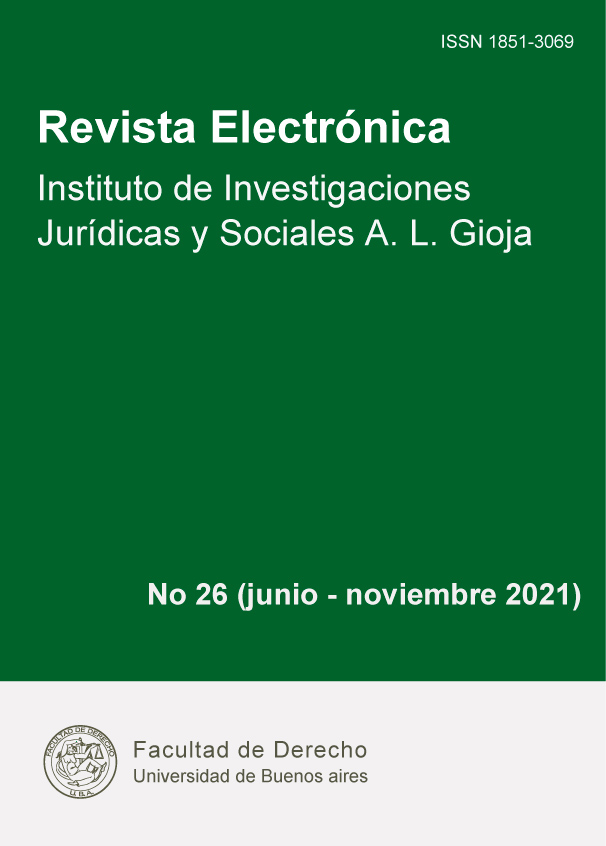Actividades cibernéticas y seguridad internacional: Hacia un régimen de normas de comportamiento estatal responsable y medidas de fomento de la confianza
Palabras clave:
Ciberspacio, TIC, derecho internacional público, Naciones Unidas, multilateralismoResumen
Este artículo tiene por fin analizar algunas cuestiones terminológicas en torno al estudio del uso malicioso de las tecnologías de la información y la comunicación (TIC) y su impacto en la seguridad y paz internacionales. En segundo lugar, abordará las características propias del ciberespacio y de las actividades cibernéticas para establecer puntos en común con otros dominios, así como particularidades que requieren un abordaje más original. Finalmente, hará una breve reseña respecto al trabajo que se viene desarrollando en las Naciones Unidas para abordar la seguridad internacional en el marco del uso de las TIC.
Descargas
Citas
Aldrich, Richard. (1996). The international legal implications of information warfare. Airpower Journal , 10 (3), 99-110.
Barkham, Jason. (2001). Information warfare and international law on the use of force. New York University Journal of International Law and Politics , 46, 57-113.
Beard, Jack. (2017). Soft law's failure on the horizon: the international code of conduct for outer space activities. U. Pa.J. Int'L. , 38 (2), 335-424.
Blake, Dunkan e Imburgia, Joseph. (2010). "Bloodless weapons"? The need to conduct legal review of certain capabilities and the implicationsof defining them as "weapons". Air Force Law Review , 66, 159-200.
Blank, Laurie. (2013). International law and cyber threats from non-state actors. International law studies , 89, 406-437.
Boothby, William. (2012). Some legal challenges posed by remote attack. International Review of the Red Cross , 94, 579-595.
Bowman, M.E. (1995). Is international law ready for the information age? Fordham International Law Journal , 19, 1935-1946.
Brenner, Susan. (2007). At light speed: attribution and response to cybercrime/terrorism/warfare. The Journal of Criminal Law and Criminology , 97, 379-475.
Buchan, Russel. (2012). Cyber attacks: unlawful uses of force or prohibited interventions? Journal of Conflict and Security Law , 17, 212-227.
Condron, Sean. (2007). Getting it right: protecting American critical infrastructure in cyberspace. Harvard Journal of Law and Technology, 20, 402-422.
Cox, Stephen. (2005). ‘Confronting Threats Through Unconventional Means: Offensive Information Warfare as Covert Alternative to Preemptive War’. Houston Law Review, 42, 881-910.
D'Amato, Anthony. (2002). International law, cybernetics, and cyberspace. International Law Studies , 76, 59-73.
Delibasis, Dimitrios. (2006). State use of force in cyberspace for self-defence: a new challenge for a new century. Peace Conflict and Development: an Interdisciplinary Journal, 8, 1-50.
Dinstein, Yoram. (2002). Computer network attacks and self-defense. International Law Studies, 76, 99-121.
Dinstein, Yoram. (2003). War, aggression and self-defense. Cambridge: Cambridge University Press.
Fidler, David. (2012). Tinker, Tailor, Soldier, Duqu: why cyberespionage is more dangerous than you think. International Journal of Critical Infrastructure Protection, 5, 28-29.
Hathaway, Oona. (2012). The law of cyberattack. California Law Review, 100, 817-886.
Hollis, Duncan. (2007). Why States need an international law for information operations. Lewis and Clark Law Review, 11, 1023-1062.
Intoccia, Gregory y Moore, Joe. (2006). Communications technology, warfare, and the law: is the network a weapon system? Houston Journal of International Law, 28, 470-490.
Johnson, Phillip. (2002). Is it time for a treaty on information warfare? International Law Studies, 76, 439-531.
Joyner, Christopher y Lotrionte, Catherine. (2001). Information warfare as international coercion: elements of a legal framework. European Journal of International Law, 12, 825-865.
Kesan, Jay y Hayes, Carol. (2012). Mitigative Counterstriking: Self-Defense and Deterrence in Cyberspace. Harvard Journal of Law and Technology, 25, 517-527.
Kuehl, Daniel. (2002). Information operations, information wafare, and computer network attack: their relationship to national security in the information age. International Law Studies, 76, 35-58.
Lin, Herbert. (2010). Offensive cyber operations and the use of force. Journal of National Security Law and Policy, 4, 63-86.
Morth, Todd. (1998). Considering our position: viewing information warfare as a use of force prohibited by article 2(4) of the UN Charter. Case Western Reserve Journal of International Law, 30, 567-600.
Raboin, Bradly. (2011). Corresponding evolution: international law and the emergence of cyber warfare. Journal of the National Association of Administrative Law Judiciary, 31, 603-668.
Robbat, Michael. (2000). Resolving the legal issues concerning the use of information warfare in the international forum: the reach of the existing legal framework, and the creation of a new paradigm. Journal of Science & Technology Law, 6, 264-289.
Roscini, Marco. (2014). Cyber operations and the use of force international law. Oxford: Oxford University Press.
Schmitt, Michael. (2001). Computer network attack: the normative software. Yearbook of International Humanitarian Law, 4, 53-85.
Schmitt, Michael. (2013). Tallinn Manual on the International Law Applicable to Cyber Warfare. Cambridge: Cambridge University Press.
Schmitt, Michael. (2002). Wired warefare: Computer network attack and the jus in bello. International Review of the Red Cross, 84, 365-398.
Schmitt, Michael y Vihul, Liis. (2014). The nature of international cyber norms. Tallin: CCDCOE.
Segura-Serrano, Antonio. (2006). Internet regulation and the role of international law. Max Planck Yearbook of United Nations Law, 10, 191-272.
Shackelford, Scott. (2009). From nuclear war to net war: analogizing cyber attacks in international law. Berkeley Journal of International Law, 27, 192-251.
Sharp, Walter. (1999). Cyberspace and the use of force. Falls Church: Aegis Research Corporation.
Tikk, Eneken y Kerttunen, Mika. (2017). The alleged demise of the UN GGE: An autopsy and eulogy, Cyber Policy Institute, 1-46.
Tsagourias, Nicholas. (2012). Cyber attacks, self-defence and the Problem of Attribution. Journal of Conflict and Security Law, 17, 229-244.
Von Clausewitz, Carl. (2007). On war. Oxford: Oxford University Press.
Walkner, Paul. (2013). Organizing for cyberspace operations: selected issues. International Law Studies, 89, 340-361.
Williams, Robert. (2011). Game change: cyber networks, intelligence collection, and covert action. The George Washington Law Review, 79, 1162-1200.
Woltag, Johann-Cristoph (2011). Computer network operations below the level of armed force. ESIL Conference Paper Series, 1(1), 1-16.
TRATADOS:
Convención de las Naciones Unidas sobre el Derecho del Mar, adoptada el 10 de diciembre de 1982 y en vigor desde el 16 de noviembre de 1994, 1833 UNTS 3.
Protocolo Adicional a los Convenios de Ginebra del 12 de agosto de 1949 relativo a la Protección de las Víctimas de los Conflictos Armados Internacionales (Protocolo I), aprobado el 8 de junio de 1977 y en vigor desde el 7 de diciembre de 1978.
Tratado sobre los principios que deben regir las actividades de los Estados en la exploración y utilización del espacio ultraterrestre, incluso la Luna y otros cuerpos celestes, adoptado el 19 de diciembre de 1966 y en vigor desde el 10 de octubre de 1967, 610 UNTS 205.
RESOLUCIONES DE ASAMBLEA GENERAL
Asamblea General de las Naciones Unidas, Resolución 53/70, 4 de diciembre de 1998, A/RES/53/70.
Asamblea General de las Naciones Unidas, Resolución 54/49, 1 de diciembre de 1999, A/RES/54/49.
Asamblea General de las Naciones Unidas, Resolución 56/19, 29 de noviembre de 2001, A/RES/56/19.
Asamblea General de las Naciones Unidas, Resolución 57/53, 22 de noviembre de 2002, A/RES/57/53.
Asamblea General de las Naciones Unidas, Resolución 58/32, 8 de diciembre de 2003, A/RES/58/32.
Asamblea General de las Naciones Unidas, Resolución 6/45, 8 de diciembre de 2005, A/RES/60/45.
Asamblea General de las Naciones Unidas, Resolución 61/54, 6 de diciembre de 2006, A/RES/61/54.
Asamblea General de las Naciones Unidas, Resolución 62/17, 5 de diciembre de 2007, A/RES/62/17.
Asamblea General de las Naciones Unidas, Resolución 63/37, 2 de diciembre de 2008, A/RES/63/37.
Asamblea General de las Naciones Unidas, Resolución 65/41, 8 de diciembre de 2010, A/RES/65/41.
Asamblea General de las Naciones Unidas, Resolución 66/24, 2 de diciembre de 2011, A/RES/66/24.
Asamblea General de las Naciones Unidas, Resolución 68/243, 27 de diciembre de 2013, A/RES/68/243.
Asamblea General de Naciones Unidas, Resolución 70/237, 23 de diciembre de 2015, A/RES/70/237.
Asamblea General de las Naciones Unidas, Resolución 73/27, 5 de diciembre de 2018, A/RES/73/27.
Asamblea General de las Naciones Unidas, Resolución 73/266, 22 de diciembre de 2018, A/RES/73/266.
INFORMES DE LOS GEG
Grupo de Expertos Gubernamentales sobre los avances en la información y las telecomunicaciones en el contexto de la seguridad internacional, UN Doc. A/65/201, 30 de julio de 2010.
Grupo de Expertos Gubernamentales sobre los Avances en la Información y las Telecomunicaciones en el Contexto de la Seguridad Internacional, UN Doc. A/68/98, 24 de junio de 2013.
Grupo de Expertos Gubernamentales sobre los Avances en la Información y las Telecomunicaciones en el Contexto de la Seguridad Internacional, A/70/174, 22 de julio de 2015.
DOCUMENTOS DE NACIONES UNIDAS
Carta de fecha 23 de septiembre de 1998 dirigida al Secretario General por el Representante Permanente de la Federación de Rusia ante las Naciones Unidas, UN Doc. A/C.1/53/3, 30 de septiembre 1998.
Los avances en la informatización y las telecomunicaciones en el contexto de la seguridad internacional, UN Doc. A/54/213, 10 de agosto 1999.
Los avances en la información y las telecomunicaciones en el contexto de la seguridad internacional, UN Doc. A/59/116, 23 de junio de 2004.
Los avances en la información y las telecomunicaciones en el contexto de la seguridad internacional, UN Doc. A/59/116/Add.1, 28 de diciembre de 2004.
Carta de fecha 12 de septiembre de 2011 dirigida al Secretario General por los Representantes Permanentes de China, la Federación de Rusia, Tayikistán y Uzbekistán ante las Naciones Unidas, UN Doc. A/66/359, 14 de septiembre de 2011.
Avances en la esfera de la información y las telecomunicaciones en el contexto de la seguridad internacional, UN Doc. A/68/156, 16 de julio de 2013.
Avances en la esfera de la información y las telecomunicaciones en el contexto de la seguridad internacional, UN Doc. A/69/112/Add.1, 18 de septiembre de 2014.
Carta de fecha 9 de enero de 2015 dirigida al Secretario General por los Representantes Permanentes de China, la Federación de Rusia, Kazajstán, Kirguistán, Tayikistán y Uzbekistán ante las Naciones Unidas, UN Doc. A/69/723, 13 de enero de 2015.
Avances en la esfera de la información y las telecomunicaciones en el contexto de la seguridad internacional, UN Doc. A/70/172, 22 de julio 2015.
Avances en la esfera de la información y las telecomunicaciones en el contexto de la seguridad internacional, UN Doc. A/71/172, 19 de Julio 2016.
Avances en la esfera de la información y las telecomunicaciones en el contexto de la seguridad internacional, UN Doc. A/72/315, 11 de agosto de 2017.
Avances en la esfera de la información y las telecomunicaciones en el contexto de la seguridad internacional, UN Doc. A/C.1/73/L.27/Rev.1, 29 de octubre de 2018.
Avances en la esfera de la información y las telecomunicaciones en el contexto de la seguridad internacional, UN Doc. A/C.1/73/L.37, 18 de octubre de 2018.
Avances en la esfera de la información y las telecomunicaciones en el contexto de la seguridad internacional, UN Doc. A/74/120, 24 de junio de 2019.
LEGISLACIÓN DOMÉSTICA
Argentina, Estrategia de Ciberseguridad, Secretaría de Gobierno de Modernización, Resolución 829/2019, publicada el 28 de mayo de 2019. Disponible en: https://www.boletinoficial.gob.ar/detalleAviso/primera/208317/20190528/
China, International Strategy of Cooperation on Cyberspace (2017), versión en inglés disponible en: http://www.xinhuanet.com//english/china/2017-03/01/c_136094371.htm/
China, Programa Nacional de medio y largo plazo para el Desarrollo de la Ciencia y la Tecnología (2006-2020), versión en inglés disponible en el repositorio de la UIT: https://www.itu.int/en/ITU-D/Cybersecurity/Pages/National-Strategies-repository.aspx/
Estados Unidos, Joint publication 3-13, 27 de noviembre de 2012. Disponible en: https://web.archive.org/web/20150208100916/http:/www.fas.org/irp/doddir/dod/jp3_13.pdf
Estados Unidos, Strategy for Homeland Defense and Civil Support of the United States (2005). Disponible en: http://www.hsd.org/
Federación de Rusia, Information Security Doctrine of the Russian Federation (2008). Versión en inglés disponible en el repositorio de UIT: https://www.itu.int/en/ITU-D/Cybersecurity/Pages/National-Strategies-repository.aspx/
DOCUMENTOS REGIONALES E INTERGUBERNAMENTALES
Asamblea General de la OEA, Resolución AG/RES. 2004 (XXXIV-O/04), 8 de junio de 2004.
Directive (EU) 2016/1148 of the European Parliament and of the Council of 6 July 2016 concerning measures for a high common level of security of network and information systems across the Union.
OTAN, Assured access to the common globals, findings and recommendations, abril 2011. Disponible en: https://www.act.nato.int/images/stories/events/2010/gc/aagc_recommendations.pdf
OTAN, NATO’S approach to space, 23 de octubre de 2020. Disponible en: https://www.nato.int/cps/en/natohq/topics_175419.htm/
OTAN, NATO Recognises Cyberspace as a ‘Domain of Operations’ at Warsaw Summit (2016). Disponible en: https://ccdcoe.org/incyder-articles/nato-recognises-cyberspace-as-a-domain-of-operations-at-warsaw-summit/
VARIOS
Comité Internacional de la Cruz Roja, Comentario de 1987 al Protocolo II a los Convenios de Ginebra del 12 de agosto de 1949, relativo a la protección de víctimas de conflicto armados no internacionales. Disponible en: https://ihl-databases.icrc.org/applic/ihl/ihl.nsf/Treaty.xsp?documentId=AA0C5BCBAB5C4A85C12563CD002D6D09&action=openDocument/
Legality of the Threat or Use of Nuclear Weapons, Advisory Opinion, I.C.J. Reports 1996, p. 226, International Court of Justice (ICJ), 8 July 1996.
Gobierno de Canadá, Canada identifies malicious cyber-activity by Russia, 4 de octubre de 2018. Disponible en: https://www.canada.ca/en/global-affairs/news/2018/10/canada-identifies-malicious-cyber-activity-by-russia.html/
Gobierno de Nueva Zelanda, Oficina de Seguridad de las Comunicaciones, Malicious cyber activity attributed to Russia, 4 de octubre de 2018. Disponible en: https://www.gcsb.govt.nz/news/malicious-cyber-activity-attributed-to-russia/
Gobierno de los Estados Unidos, Departamento de Justicia, U.S. Charges Russian GRU Officers with International Hacking and Related Influence and Disinformation Operations, 4 de octubre de 2018. Disponible en: https://www.justice.gov/opa/pr/us-charges-russian-gru-officers-international-hacking-and-related-influence-and/
Gobierno de los Estados Unidos, Departamento de Justicia, Two Chinese Hackers Associated With the Ministry of State Security Charged with Global Computer Intrusion Campaigns Targeting Intellectual Property and Confidential Business Information, 20 de diciembre de 2018. Disponible en: https://www.justice.gov/opa/pr/two-chinese-hackers-associated-ministry-state-security-charged-global-computer-intrusion/
Gobierno del Reino Unido, UK and allies reveal global scale of Chinese cyber campaign, 20 de diciembre de 2018. Disponible en: https://www.gov.uk/government/news/uk-and-allies-reveal-global-scale-of-chinese-cyber-campaign/
Proyecto de Convención sobre Seguridad de la información Internacional, 22 septiembre de 2011. Disponible en el sitio del Ministerio de Relaciones Exteriores de la Federación de Rusia: https://www.mid.ru/en/foreign_policy/official_documents/-/asset_publisher/CptICkB6BZ29/content/id/191666/
Tabachnik, Alexander y Topor, Lev. (2020). Russian cyber sovereignty: one step ahead. Russian International Affairs Council. Disponible en: https://russiancouncil.ru/en/analytics-and-comments/analytics/russian-cyber-sovereignty-one-step-ahead/#:~:text=its%20global%20adversaries.-,A%20U.S.%20special%20report%20from%20August%202020%20concluded%20that%20Russia,the%20U.S.%20and%20the%20EU
Unión Internacional de Telecomunicaciones, Guide to Developing a National Cybersecurity Strategy. Disponible en: https://www.itu.int/en/ITU-D/Cybersecurity/Pages/cybersecurity-national-strategies.aspx/
*Todos los enlaces fueron verificados el 5 de marzo de 2021.
Descargas
Publicado
Número
Sección
Licencia

Esta obra está bajo una licencia internacional Creative Commons Atribución-NoComercial 4.0.
Los/as autores/as que publican en esta revista están de acuerdo con los siguientes términos:
1. Los/as autores/as conservan los derechos de autor y garantizan a la revista el derecho de ser la primera publicación del trabajo al igual que licenciado bajo una Creative Commons Attribution-NonCommercial 4.0 International License que permite a otros compartir el trabajo con un reconocimiento de la autoría del trabajo y la publicación inicial en esta revista.
2. Los/as autores/as pueden establecer por separado acuerdos adicionales para la distribución no exclusiva de la versión de la obra publicada en la revista (por ejemplo, situarlo en un repositorio institucional o publicarlo en un libro), con un reconocimiento de su publicación inicial en esta revista.
3. Se permite y se anima a los/as autores/as a difundir sus trabajos electrónicamente (por ejemplo, en repositorios institucionales o en su propio sitio web) antes y durante el proceso de envío, ya que puede dar lugar a intercambios productivos, así como a una citación más temprana y mayor de los trabajos publicados (Véase The Effect of Open Access) (en inglés).














